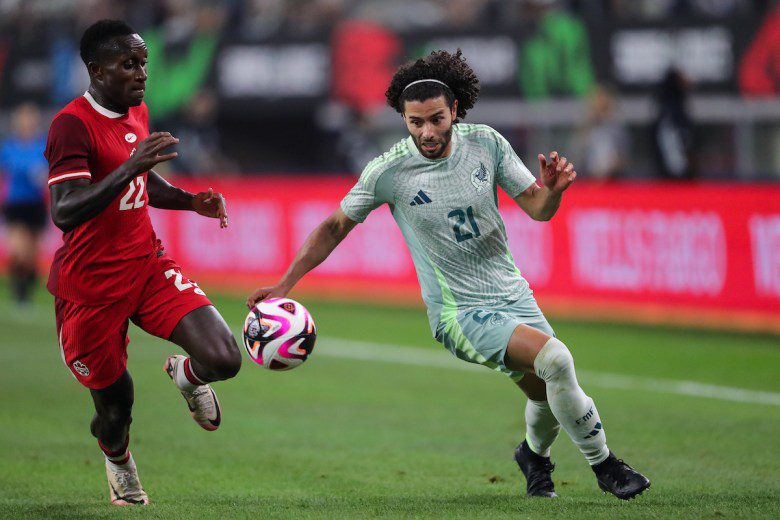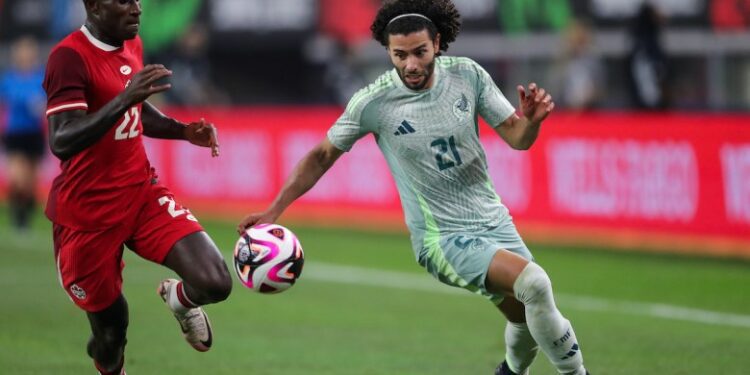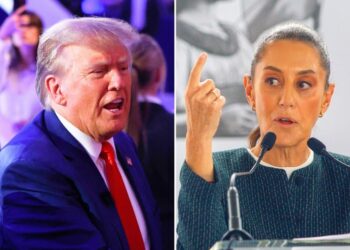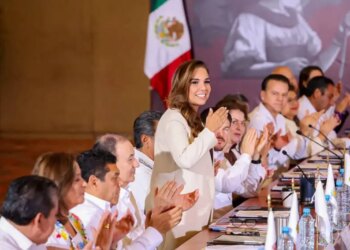Not so bad a start, no matter the circumstances and all things considered, to Javier Aguirre’s third stint as Mexico’s national team head coach. Now comes the hard part.
First, winning over a massive, impassioned and demanding fan base that’s understandably dissatisfied with what’s gone down the past four years as the country’s federation has increasingly slipped into disrepair and the formerly prosperous flow of talent trickled to mere drips. And then, as if by magic, returning El Tri to its proper place — and in time for the World Cup that edges closer every day.
The dominant if labored 3-0 victory over New Zealand in Southern California and an often ugly scoreless tie with Canada in Texas hardly hearkened to the standard in place before the pandemic, and the followers made their feelings heard. Mostly by staying away — the crowds at the Rose Bowl and AT&T Stadium were unseemly diminished from the norm — and then booing their team off the field as Aguirre’s four-day “MexTour” debut wrapped up.
This is just a start, reminds the veteran coach, an influential midfielder on El Tri’s 1986 World Cup team whose previous two terms in the job began in troubled qualifying campaigns and closed in the 2002 and 2010 World Cup rounds of 16. Things are different this time, he says: Results are secondary and there’s time to construct a side that can make Mexicans proud ahead of 2026 and its World Cup home games.
The 65-year-old Aguirre, who in late July took charge following Jaime Lozano’s dismissal in the wake of the unsettling Copa America showing, comes in like an old hand, with a needed gravitas and clear understanding of what it’s all about. And he’s got Rafa Marquez, among the greatest talents and leaders Mexico has produced, at his side.
He is preaching patience and promising success, but the challenges he faces are thornier than those he encountered the first two times. Mexico’s pool of talent isn’t what it’s been the past four decades, certainly nothing like a decade ago, and its traditional swagger is absent. It’ll take a steady and savvy hand to right what’s wrong, all while needing to assuage a following that demands graceful, incisive futbol and decisive victories.
“Truly we came in at a very delicate moment,” he said in Spanish following the New Zealand victory. “The past three coaches [Argentines Tata Martino and Diego Cocca before Lozano] managed the same amount of players, the same quality of players, as we will, but that’s what we’re doing. That’s our job, to look for players, to focus on our strengths and correct our weaknesses, and in these two years [leading to the World Cup], we’re going to try to look for talent, new players, and show up with a national team that is fully prepared to compete.”
What Aguirre most wants, he says, is “to give fans what they’re looking for … make sure all the fans leave happy with what they see,” and that, he says, requires a commitment to the idea that there is no higher calling in this sport than representing Mexico.
His players, he says, will make that commitment.
“I cannot conceive of a team led by me that does not run, that does not fight, that does not feel the colors. I cannot conceive of that,” Aguirre said following Tuesday night’s draw in Arlington. “The player who does not understand this philosophy can go home.”
‘Are they Mexicans? Are they footballers’
Aguirre’s first roster, like Lozano’s last, blended youth with experience while omitting the goalkeeping legend Guillermo “Memo” Ochoa (who then completed a move to Portuguese top-tier club AVS to “keep up the idea of making the Mexico national team in my hopes and to play” in a sixth World Cup), incoming San Diego FC winger Hirving “Chucky” Lozano, 33-goal striker Raul Jimenez, and Houston Dynamo talisman Hector Herrera.
All but Lozano are past 30, considerably so, but Aguirre says he’s not eliminating anyone from consideration. If you’re playing, you could be called in.
“Are they Mexican? Are they footballers? Well, they’re in all of our orbits,” Aguirre said in his initial media appearance after taking the assignment. “There are parameters, obviously. There’s an idea, we try to follow it, but we’re also interested in good footballers and Mexicans who are proud to be in the national team.”
 Mexico’s Cesar “Chino” Huerta (right) battles with Canada’s Richie Laryea during a 0-0 friendly tie Sept. 10 in Arlington, Texas. (Photo: Brian McLean/ZUMA Press Wire via ISI Photos)
Mexico’s Cesar “Chino” Huerta (right) battles with Canada’s Richie Laryea during a 0-0 friendly tie Sept. 10 in Arlington, Texas. (Photo: Brian McLean/ZUMA Press Wire via ISI Photos)
The grit and fight he wants to require, if not so much the style and precision, was certainly present in his first two games. El Tri came out aggressively Saturday night against New Zealand, no surprise, were ahead just five minutes in, and their workmanlike performance evolved into something more once 23-year-old Pumas UNAM winger Cesar “Chino” Huerta came on early in the second half.
They struggled to find space or conquer Canada’s counterpress until after the break three days later and responded physically, disrupting their foe with 24 fouls (the Canadians committed 18) while shutting off access to its goal but for one occasion, a Cyle Larin header near the end of the first half that Club America’s Angel Malagon dived to push aside.
“I really liked the attitude,” Aguirre said after the first game. “And even though it wasn’t our best game, the team searched. … They had a wonderful disposition and a great attitude.”
Mexico was better after halftime in both games. Huerta, who came on against New Zealand when Colombian-born Al Qadsiah winger Julian Quiñones tweaked a hamstring at the start of the second half, provided great energy, doubled Mexico’s advantage on his first touch, should have had a second a minute later, then started the sequence for Cruz Azul midfielder Luis Romo‘s strike three minutes after that. He was a constant threat, and was rewarded with a start against Canada.
El Tri was outclassed the first 45 in the second game, then took charge after the break and was unfortunate not to win. Santiago Gimenez, whose productivity with Feyenoord has not been approached internationally, should have done better with a one-on-one chance in the 54th minute — his goalless stretch with Mexico reached 14 games — Dayne St. Clair tipped Roberto Alvarado‘s blast over the crossbar in the 72nd, and Alphonso Davies got in the way of a Johan Vasquez shot in the 84th, the last two of these chances arriving from debris in the box.
The foundation for the roster in 2026 is in place, for good or ill, and Aguirre fielded veteran sides. He recalled three key players left off the Copa America list — Toluca left back Jesus Gallardo, who won his 99th cap against New Zealand; Cruz Azul midfielder Luis Romo, who fed the second and scored the third goals in that win, and America striker Henry Martin, who came off the bench in both games — and used an experienced midfield group in a 4-2-3-1 formation designed to provide a stronger core. Veterans got the call in midfield: Orbelin Pineda, who scored the fifth-minute opener and assisted on Romo’s strike, and Guadalajara winger Robert Alvarado started both games, and Luis Chavez might have but limped off with an injury before the first night was done.
Aguirre’s long-term goal, to supplement these vets with new talent, comes with an eye on 2030, when Marquez is expected to be running the team.
“We’re looking for players who get a lot of minutes with their clubs, and I think that’s really great for looking for young blood in the national team …,” said Aguirre, who gave Guadalajara goalkeeper Raul Rangel his second cap in the opener, Monterrey center back Victor Guzman his fifth against Canada, and Pumas UNAM Erik Lira his fifth and sixth, with a start in game two. “We need to look [for eligible players elsewhere], and that way we’re coming in strong for the World Cup in 2026, and in 2030 we’re also coming in strong with a fresh group of players.”
Several young Mexican players are in Europe — 23-year-old LA Galaxy product Julian Araujo, who left Barcelona for Bournemouth, started against Canada, and eyes are on Athletic Bilbao backup goalkeeper Alex Padilla and FC Copenhagen Rodrigo Huescas, both 20 — and the prospect that 17-year-old Mexico City-born Brazilian phenom Matheus Reis, called up by the U-18s, might suit up for El Tri certainly is enticing.
Aguirre called thrice-capped UANL Tigres attacker Marcelo Flores, who developed in England, an “interesting” player but didn’t use him in these games. His eyes are open for others.
“We have to find the 23 best players for Mexico in these next two years,” he said. “No one has their doors closed from my national team.”
‘You can never say no to your country’
Duilio Davino, the Mexican federation’s sporting director, played for Aguirre during a stretch of his time with the national team and as Monterrey’s director hired him as coach three years ago. This was an easy hire.
“He is a Javier Aguirre with much more learning, more games, more victories, more failures, and that, without a doubt, makes him a better coach,” Davino told Los Angeles Times en Español. “He is a Javier Aguirre who, due to his age, has a coaching staff that listens more and can delegate and can make better decisions.”
Said Gallardo, to TUDN: “We know what [Aguirre] represents for the national team and for the entire career he has had here in Mexico and in Europe. … And we know [Marquez] on and off the field. He was a great player, is a great coach … and we have to take all the experience he has and learn a lot from them.”
Aguirre jumped at the chance.
“You can never say no to your country …,” he said in Pasadena. “I feel very privileged for the country to call me back. It gives me a lot of pride, and it’s very exciting. It’s like the first time, you come in a little tense and you hear all the fans at trainings and the players. The day I lose that [feeling], I think it’s the last day.”
Now he faces work dissimilar when he took the reins in 2001 and 2009. Mexico was fifth in the Concacaf Hexagonal the first time, and he guided it to second and, the high point, into the Copa America title game. El Tri had lost two of their first three qualifiers the second time, but he steered it comfortably through the process, won a Gold Cup title and beat the USA outside of Mexico for the first time in a decade.
Both ended in the World Cup round of 16, just short of the quarterfinal berth everyone so desperately desires. Mexico has gone that far just twice, in 1970 and 1986, when it played at home. Now the tournament returns, and the path isn’t so well-defined nor simple. The list of potential foes is limited by the Nations League’s increased presence within international windows, meaning another Concacaf opponent, some of them far beneath Mexico’s level, rather than a strong European or South American encounter.
“This is different than the last two times,” Aguirre said. “There isn’t the necessity to come in and start winning, but just because we don’t need to win doesn’t mean we’re not going to give our best to do so. This [roster] is a more mature version of the team, and it’s not about bringing in random players and ‘we have to win, and that’s it.’
“No, we have time to prepare. It’s not easy because of the FIFA fates, but I think this is the right time for me to come into this national team. We have time.”
On Oct. 15, Mexico faces the USA in a friendly in Guadalajara.
“We’re trying our best to cover up holes that are in our game,” Aguirre said, “but as of right now, we’re coming into the World Cup, and this is a great project. …
“Things are being done correctly. This is a great moment.”
Source link : http://www.bing.com/news/apiclick.aspx?ref=FexRss&aid=&tid=66e26222971f480b8360a9399e5c6749&url=https%3A%2F%2Fwww.socceramerica.com%2Fmexicos-well-seasoned-new-coach-javier-aguirre-details-his-method-to-get-el-tris-mojo-back%2F&c=12498310223180041711&mkt=en-us
Author :
Publish date : 2024-09-11 14:21:00
Copyright for syndicated content belongs to the linked Source.






